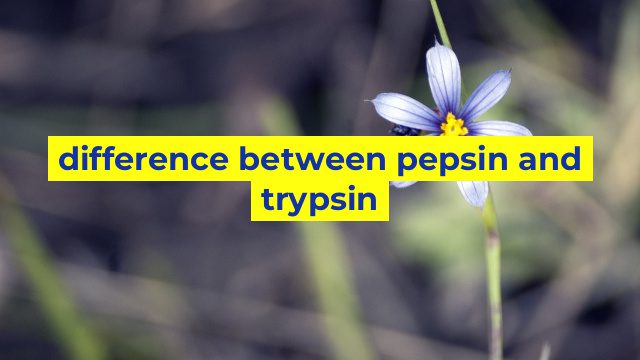The Key Differences Between Pepsin and Trypsin
When it comes to digestion, enzymes play a vital role in breaking down the food we eat into smaller and more manageable forms. Two vital enzymes that help with this process are pepsin and trypsin. While both of these enzymes work towards breaking down proteins, there are several differences between them that are worth understanding.
What is Pepsin?
Pepsin is an enzyme that is secreted by the stomach lining. It works in the acidic environment of the stomach and is responsible for breaking down proteins into smaller peptides. It is activated in the presence of hydrochloric acid and works best at a pH of around 2.0. Pepsin is especially important in breaking down dietary proteins before they enter the small intestine, where the absorption of amino acids occurs.
What is Trypsin?
Trypsin is another enzyme that helps break down proteins. Unlike pepsin, trypsin is secreted by the pancreas, and comes into play when partially digested food exits the stomach and enters the small intestine. Trypsin works in a basic environment and is activated by another enzyme, called enterokinase, which is secreted by the small intestine. Once activated, trypsin breaks down larger peptides into even smaller peptides and amino acids, which can then be absorbed into the bloodstream.
Differences Between Pepsin and Trypsin
While both pepsin and trypsin break down proteins, there are a few key differences between these two enzymes. Here are some of the most notable differences:
1. Source: Pepsin is secreted by the stomach whereas trypsin is secreted by the pancreas.
2. Activation: Pepsin is activated by hydrochloric acid whereas trypsin is activated by enterokinase.
3. Environment: Pepsin works in an acidic environment (pH 2.0) whereas trypsin works in a basic environment (pH 8.0).
4. Substrates: Pepsin breaks down proteins into smaller peptides whereas trypsin breaks down larger peptides into smaller peptides and amino acids.
5. Location: Pepsin primarily works in the stomach whereas trypsin works in the small intestine.
Conclusion
Understanding the differences between pepsin and trypsin is important for anyone looking to maintain a healthy digestive system. Both of these enzymes play a crucial role in breaking down proteins and ensuring that they are absorbed properly by the body. Knowing how these enzymes work, and where they come from, can help us make informed decisions about our diet and overall health.
Table difference between pepsin and trypsin
| Enzyme | Definition | Location of Secretion | Optimal pH Range | Substrate | Product of Digestion |
|---|---|---|---|---|---|
| Pepsin | Proteolytic enzyme that breaks down peptide bonds in proteins | Chief cells of gastric glands in the stomach | pH 1.5-2.5 | Proteins | Shorter polypeptides and some amino acids |
| Trypsin | Proteolytic enzyme that breaks down peptide bonds in proteins | Pancreatic acinar cells in the pancreas | pH 7.8-8.7 | Proteins | Shorter polypeptides and some amino acids |


